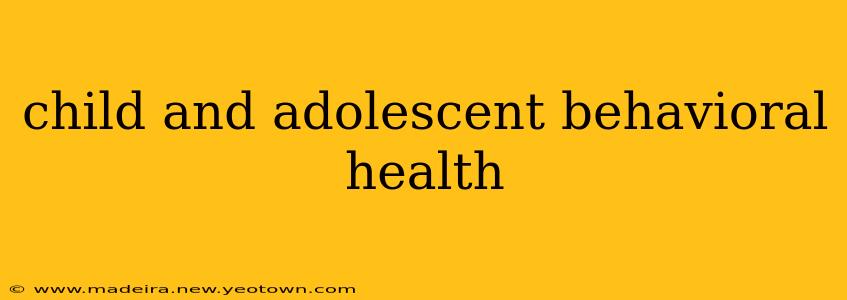The journey of raising a child is a rollercoaster of emotions, milestones, and, inevitably, challenges. For many parents, the path becomes even more intricate when navigating the complexities of child and adolescent behavioral health. Understanding this landscape, from recognizing potential issues to seeking effective interventions, is crucial for fostering healthy development and well-being. This isn't just about dealing with "bad behavior"; it's about understanding the underlying causes and providing the right support. Let's embark on this journey together, exploring the intricacies of child and adolescent behavioral health.
What are some common behavioral challenges in children and adolescents?
Childhood and adolescence are periods of significant developmental change, and behavioral challenges are common. These aren't always signs of a serious disorder, but rather normal developmental hurdles. However, some behaviors require professional attention. Common challenges include:
- Oppositional Defiant Disorder (ODD): Characterized by persistent angry or irritable mood, argumentative or defiant behavior, and vindictiveness.
- Conduct Disorder (CD): A more severe pattern of violating the basic rights of others or major age-appropriate societal norms or rules.
- Anxiety Disorders: These manifest in various ways, from separation anxiety to social anxiety and generalized anxiety, often impacting school performance and social interactions.
- Depression: Symptoms can range from persistent sadness and loss of interest to changes in sleep, appetite, and energy levels. In adolescents, this can manifest as irritability and anger.
- Attention-Deficit/Hyperactivity Disorder (ADHD): Characterized by inattention, hyperactivity, and impulsivity, affecting schoolwork, relationships, and self-esteem.
- Autism Spectrum Disorder (ASD): This neurodevelopmental disorder affects communication, social interaction, and behavior. Each individual experiences autism differently.
- Trauma-Related Disorders: Resulting from exposure to traumatic events, these disorders can cause significant emotional and behavioral disturbances.
What are the warning signs that a child or adolescent needs professional help?
Recognizing when a child needs professional help can be tricky. There's no single indicator, but persistent and significant deviations from typical development warrant attention. Watch for:
- Significant changes in behavior: Sudden or persistent changes in mood, sleep, appetite, school performance, or social interactions.
- Self-harm or suicidal thoughts: These are serious warning signs requiring immediate professional intervention.
- Difficulty functioning in daily life: Struggling to cope with school, relationships, or everyday tasks.
- Persistent disruptive behaviors: Behaviors that significantly disrupt family life, school, or community settings.
- Significant emotional distress: Persistent sadness, anxiety, or anger that interferes with daily life.
What are the different types of treatment available for child and adolescent behavioral health issues?
Treatment approaches vary depending on the specific diagnosis and individual needs. Common interventions include:
- Therapy: Individual, family, and group therapy can provide a safe space to explore feelings, develop coping mechanisms, and improve communication. Cognitive Behavioral Therapy (CBT) and Dialectical Behavior Therapy (DBT) are commonly used.
- Medication: In some cases, medication may be prescribed by a psychiatrist to manage symptoms. This is often used in conjunction with therapy.
- School-based interventions: Schools can provide support through individualized education plans (IEPs), 504 plans, and behavioral interventions.
- Parent training: Parents learn strategies to manage challenging behaviors and create a supportive home environment.
How can parents support their child's behavioral health?
Parental support is crucial. Creating a supportive and understanding environment is fundamental. Parents can:
- Learn about the specific challenges: Understand the child's diagnosis and potential treatment options.
- Develop positive parenting strategies: Focus on rewarding positive behaviors and using consistent discipline.
- Maintain open communication: Encourage the child to express their feelings and concerns.
- Seek support for themselves: Parenting a child with behavioral health challenges can be stressful. Support groups and parental counseling can be beneficial.
What are the long-term effects of untreated behavioral health issues in children and adolescents?
Untreated behavioral health issues can have significant long-term consequences, impacting:
- Academic achievement: Difficulty focusing, attending school, and performing academically.
- Social relationships: Challenges forming and maintaining healthy relationships.
- Employment opportunities: Difficulties maintaining employment due to behavioral or emotional challenges.
- Mental health: Increased risk of developing more severe mental health problems in adulthood.
- Substance abuse: Higher likelihood of substance use disorders.
This journey into child and adolescent behavioral health provides only a starting point. Remember, seeking professional help is a sign of strength, not weakness. Early intervention is key to promoting healthy development and improving long-term outcomes. By fostering understanding, providing support, and accessing appropriate resources, we can help children and adolescents thrive.

